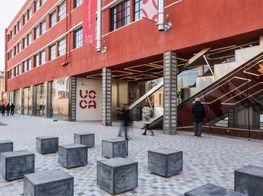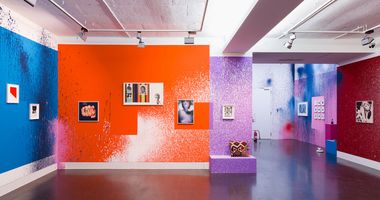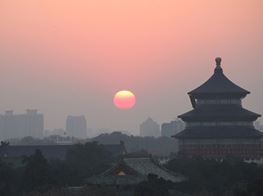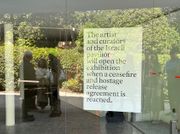Philip Tinari
Courtesy Philip Tinari.
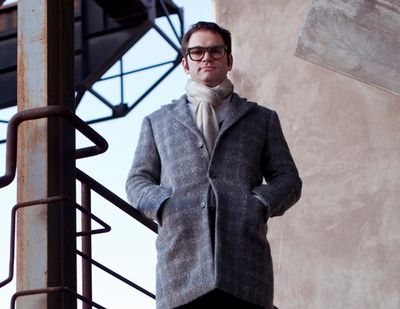
Courtesy Philip Tinari.
Philip Tinari is director of the Ullens Center for Contemporary Art (UCCA), Beijing, an independent museum in Beijing's 798 Art District with an annual public of over half a million visitors.
He is also founding editor of the art magazine LEAP, contributing editor to Artforum, and adjunct professor in the College of Humanities at the Central Academy of Fine Arts. Since joining UCCA last year he has curated exhibitions and projects with artists including Gu Dexin, Yun-Fei Ji, Kan Xuan, and Yung-Ho Chang. He recently co-edited the books The Future Will Be...(China Edition) and Ai Weiwei: Dropping the Urn. Having lived in Beijing for much of the past decade, he has written and lectured widely on contemporary art in China.
UCCA is unique in China for the scope of its founding ambition, the consistency of its program over the five years since its founding, and its ongoing commitment to its public.
OYou have been firmly connected in the Chinese contemporary art scene for over a decade in various roles including curator, editor, advisor and writer. What drew you to China and in particular Chinese contemporary art?
PTI came to contemporary Chinese art through a strange combination of cultural studies, literary theory, and old-school sinology. As an undergraduate in the Program in Literature at Duke, I was struck by the relevance of this arena of cultural production to the bigger questions of our moment—questions about globalization, political reform, and shifts of power.
Of course upon getting to know the art and artists of the place, I became somewhat obsessively interested in understanding the range of practices making up the Chinese art world. It was surprising but also thrilling when what seemed like an esoteric academic interest grew into a full-fledged field of endeavor.
OWhat are the most significant changes in the Chinese contemporary art scene you have witnessed during your time working in China?
PTIt has become an open scene, as opposed to a closed circle. Ten years ago there was maybe an exhibition each month, and you could keep the numbers of all the main players in the field in a single Moleskine. Today it's an industry with its own institutional and commercial infrastructure, media discourse, and governmental support.
This maturation has happened at warp speed, and the original band of players I first encountered a decade ago are for the most part all still around, doing bigger and better things than they ever imagined. The weird part is how desensitized the field has become to change at this scale.
ODecember will signal your first year as Director of the UCCA. What drew you to the UCCA and how have you found running a large institution in China?
PTUCCA is unique in China for the scope of its founding ambition, the consistency of its program over the five years since its founding, and its ongoing commitment to its public. We are neither commercial nor governmental, and this allows us to program based on what we feel is urgent and interesting to present, rather than on any external pressures. The chance to work here was irresistible.
OWho makes up the typical audience at the UCCA? Is this evolving as contemporary art becomes more accessible?
PTIt has been an amazing experience to present exhibitions to our audience, which this year will total around 800,000 visitors. This audience is actually a lot of different audiences, each of whom encounter contemporary art on different terms and premises.
We know it is nearly 90% Chinese, and that it skews relatively young. The art world makes up a portion of this but because we are situated in a district as well-known as 798—with its 3 million visitors each year—we are able to reach a wide cross-section of the general public.
OIs any of the exhibition space devoted to the permanent collection?
PTUnfortunately given the current ambiguous state of art import policy, it is not viable to show the collection—which resides in Geneva—here at UCCA. Perhaps a day will come when this can be done in a safe and rational way. For now though, other than a few works on long-term display throughout our premises, we are an entirely exhibition-driven institution, and we are fine with that.
One needs to provide a lot of context and offer different and parallel approaches to the subject matter for a audience that might not be so familiar with well known names of Western art.
OWhat percentage of exhibitions at the UCCA are international? Is interest in international contemporary art increasing in China?
PTWe aim for something around a 50/50 split between "Chinese" and "international," though this also varies from year to year, and international does not mean Euro-American.
This past year for example, we presented Indian Highway, in what was the most comprehensive exhibition of art from the subcontinent to appear in China to date. This show got a great response as there was quite a lot of curiosity from the general public about what is going on in the BRIC next door. It was exciting for us because this kind of exchange is not happening within the context of the official system.
OWhat are the challenges in presenting international contemporary art to a Chinese audience? How much is 'lost in translation'?
PTOne needs to provide a lot of context and offer different and parallel approaches to the subject matter for a audience that might not be so familiar with well known names of Western art. The first show I worked on here was with the magazine Parkett, a complete library of their editions with 192 major artists.
We came up with a nice framing conceit—the show was titled Inside a Book a House of Gold after a line from a Song-dynasty poem, and the exhibition was structured as a house, with different thematic rooms. If one accepts the premise that translation is never perfect—that a good translation is one which opens up the text for newer, poetically parallel readings—then a lot becomes possible.
OAre you still finding time to work on LEAP magazine?
PTUnfortunately, no—I had to give LEAP up in order to focus fully on the pressing job of running UCCA. It was an incredible experience to conceive and launch an art magazine from scratch, and I'm happy to see that it continues under the able management of a new team.
I became somewhat obsessively interested in understanding the range of practices making up the Chinese art world. It was surprising but also thrilling when what seemed like an esoteric academic interest grew into a full-fledged field of endeavor.
OWhat shows have you got planned for 2013?
PTWe begin the new year on a very strong note, with a massive group show called ON|OFF: China's Young Artists in Concept and Practice, which brings together significant new works by 50 artists whom we feel are representative of the generation that has emerged in the last few years, the generation born at the dawn of "Opening and Reform" in the late 1970s and early 1980s.
We are working on an international tour for this exhibition, as we feel it makes a fantastic introduction to this moment—rather than the "Mao with a Coke Can" period that many people abroad still think of when they hear the three words "Chinese contemporary art."
Later in the year we have a major retrospective by the painter Wang Xingwei, one of the freshest and most nuanced voices in art today. Titled The Interrogation of the Penguin after one of his canvases, it brings together nearly 80 of his works and is divided not by time or theme but by perspective into four sections: frontal, rear, profile, and partial profile views. This will open just before Art Basel Hong Kong and we hope will make a splash on the international scene as well.
We are also working on exhibitions with international artists including Duchamp, Taryn Simon, Tehching Hsieh, Teppei Kaneuji, and Tino Sehgal, so it should be quite an exciting year at UCCA. —[O]

